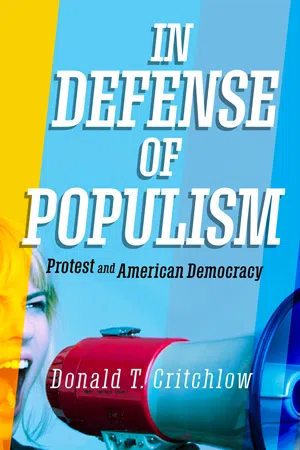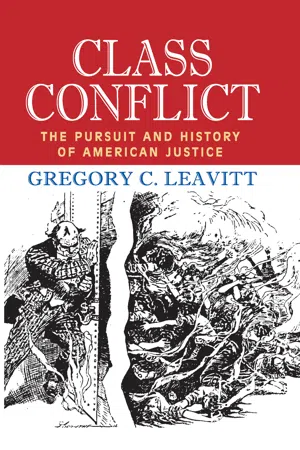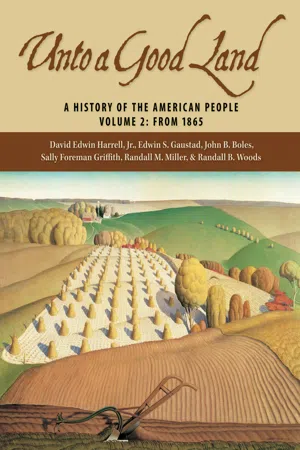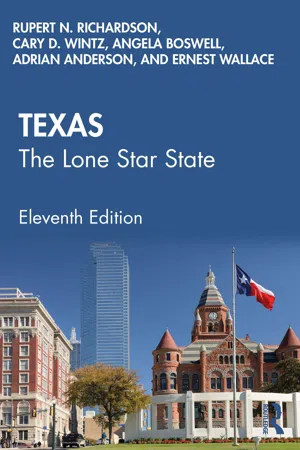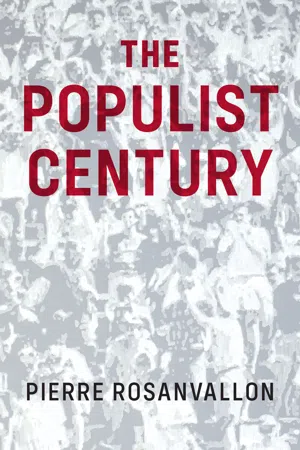History
The People's Party
The People's Party, also known as the Populist Party, was a political party in the United States during the late 19th century. It emerged as a voice for farmers and laborers, advocating for economic reforms such as the free coinage of silver and government ownership of railroads. The party's platform also included calls for direct election of senators and a progressive income tax.
Written by Perlego with AI-assistance
Related key terms
Related key terms
1 of 4
Related key terms
1 of 3
7 Key excerpts on "The People's Party"
- eBook - ePub
In Defense of Populism
Protest and American Democracy
- Donald T. Critchlow(Author)
- 2020(Publication Date)
- University of Pennsylvania Press(Publisher)
37 The Republican Party dominated in most midwestern states, but in its pursuit of economic growth, the party became aligned, if not controlled, by business interests, especially railroads. As a consequence, midwestern Republicans resisted change, and once confronted by grassroots Populist agitation, the GOP responded too late to prevent third-party mobilization. In most midwestern states, Democrats were a minority party, so they were open to forming alliances with the emerging Populist movement. Democrats in the South maintained power by playing on racial fears of poor white voters. In states where two-party competition was higher, the Populists tended to do less well.Although many Populist speakers and leaders spoke of Thomas Jefferson’s vision of an agrarian republic, the People’s Party was forward looking in its call for government regulation of industry and in its support for direct election of U.S. senators, secret ballots, women’s suffrage, and an income tax.38 The party supported the formation of agricultural cooperatives to bring business efficiency to farmers. Although the People’s Party platform in 1892 and 1896 included a plank calling for government ownership of railroads and communications systems, this plank was contentious from the outset. The People’s Party was not a socialist party.The three principal goals of the Populist movement were regulation of industry, federal aid to farmers, and monetary reform. Monetary reform included demands to replace the gold standard with government paper money and new silver coins.39 The idea was to expand the money supply. The reform press circulated books and pamphlets, such as Sarah Emery’s Seven Financial Conspiracies (1887), Seymour Norton’s Ten Men of Money Island (1887), and William Harvey’s extremely popular pamphlet Coin’s Financial School - John Haskell(Author)
- 2018(Publication Date)
- Routledge(Publisher)
The Populist party formed at that time served as a fusion vehicle for a wide range of largely rural protest movements and parties. The centerpiece of its appeal was in the form of a partly mythical nostalgia for a bygone era in which the small farmer was in control of his life and a deep suspicion of those people and forces responsible for change. In most of the country, including the nonslaveholding parts of the South, farming was equated with independence, democracy, and self-government, not with a feudal tradition as in some other countries. Agrarian life was the source of the American democratic tradition, and Populists' belief in democracy derived from those roots as well as the belief in the essential goodness and wisdom of the common man, particularly as compared to the wickedness of those among the elite in the East who looked down on them and cared nothing for their way of life. But the Populist party was based on far more than just wistful nostalgia. Contemporary historians stress the insistently radical nature of the Populist platform, which called on the federal government to redistribute wealth and take responsibility for the common good and smooth out some of the rough edges of corporate capitalism. 15 Populists proposed an increase in the money supply and strict regulation of the railroads so that farmers who depended on the rails for distribution of their products would no longer be gouged by the industrialists. They called for the right of labor to negotiate with management, an end to brutal strike-breaking practices, shorter workdays, as well as numerous changes in the political system to move in the direction of more direct democracy in order to bypass the corrupt politicians and political parties that were bought off by big corporations. The party promised that these reforms would bring back the days when the individual had a chance to compete before true free enterprise was destroyed by rapacious and predatory industrial monopolists- eBook - ePub
Class Conflict
The Pursuit and History of American Justice
- Gregory C. Leavitt(Author)
- 2017(Publication Date)
- Routledge(Publisher)
Though strongly supportive of the urban industrial labor movement, the Populist Movement was largely an agrarian farmer’s faction. Among other things, farmers wanted regulation of railroad rates, heavy taxes imposed on land held only for speculation, an increase in the money supply, and an end to foreclosures. Well organized, the Popu-list Alliance had two hundred thousand members in three thousand sub-alliances by 1887. Five years later, Populist speakers had covered most states and had reached some two million farm families. “It was a drive based on the idea of cooperation, of farmers creating their own culture, their own political parties, gaining a respect not given them by the nation’s powerful industrial and political leaders” (Zinn 1995[1980]:280). By 1889, the National Farmers Alliance had gained some four hundred thousand members.The Populist Movement and Party were class-conscious entities. As Dubofsky and Dulles (2010[1949]:162) observe, “[P]opulism challenged the whole concept of government by organized wealth. In very much the same pattern as Jacksonian Democracy, it strove to recover for the common people the political power that was felt to have been usurped by the business community. The Populist Party . . . accepted as its basic premise the idea that wealth belonged to those who produced it, and called for a union of all the laboring elements in the nation to uphold their rights.”A broader statement of the Populist ideology can be found in the party’s platform—actually called the People’s Party—stated at their first convention in 1892:We meet in the midst of a nation brought to the verge of moral, political and material ruin. Corruption dominates the ballot box, the legislatures, the Congress, and touches even the ermine of the bench. The people are demoralized . . . the newspapers are subsidized or muzzled; public opinion silenced; business prostrate, our homes covered with mortgages, labor impoverished, and the land concentrating in the hands of capitalists. The urban workmen are denied the right of organization for self-protection; imported pauperized labor beats down their wages; a hireling standing army . . . established to shoot them down. . . .The fruits of the toil of millions are boldly stolen to build up colossal fortunes. . . . From the same prolific womb of governmental injustice we breed two classes—paupers and millionaires (in Zinn 1995[1980]:282–283). - eBook - ePub
Unto a Good Land
A History of the American People, Volume 2: From 1865
- David Edwin Harrell, Edwin S. Gaustad, John B. Boles, Sally Foreman Griffith(Authors)
- 2005(Publication Date)
- Eerdmans(Publisher)
Caesar’s Column (1891), about a dark future of class oppression, set the tone for the party’s national mission. He described the nation as on “the verge of moral, political, and material ruin,” with corruption everywhere, the people demoralized, and justice impatient. The People’s Party wanted nothing less than national redemption.Populist Themes
Conservative critics painted the Populists as a monstrous hybrid of hayseeds and socialists. Admittedly, populism presented a tangle of contradictions, at once radical in economic proposals and conservative in social ones, demanding an expansion of federal authority and a restoration of local power. Calls for inflation did not sit well with many workers, and the movement’s anti-Semitism (speakers like Lease railed against what they called “the international Jewish banking conspiracy”), nativism, and extreme rhetoric alienated Catholic, Jewish, and other immigrants. But the real reason conservatives feared populism was the Populist Party’s insistence on a collective, national responsibility for people’s well-being and its assault on the principle of laissez-faire. The Populist Party posed a real threat to politics as usual. In the South, for example, the Populists openly courted African Americans. A parallel alliance movement, the Colored Farmers’ National Alliance and Cooperative Union, had grown to a quarter million members, with branches in every southern state, by 1892. Populists wanted their votes. Several bold Populist speakers attacked lynch law and emphasized the common interests of poor farmers that transcended race.The Populists’ fervid campaigning and calls for a reordering of the economy and politics did not bring electoral victory. Weaver garnered a million popular votes nationwide, and Populists won local races in Kansas and other western states. The Populists failed in the South, however, as race-baiters drove a wedge into the movement by conjuring up fears of “Negro rule.” Watson lost his congressional seat, and racial antagonisms intensified as a result of the election. The immediate legacy of the Populists’ broken bid for African Americans’ support would be disfranchisement and “Jim Crow” (see Chapter 16 - eBook - ePub
Texas
The Lone Star State
- Rupert N. Richardson, Cary D. Wintz, Angela Boswell, Adrian Anderson, Ernest Wallace(Authors)
- 2021(Publication Date)
- Routledge(Publisher)
Reforms either promised or accomplished by Governor Hogg and the Democrats temporarily quieted criticism from the Farmers’ Alliance, but the Democrats did not go far enough to suit the more militant radicals. Their support for government ownership of railroads and similar proposals found little sympathy among Democratic leaders. Governor Hogg’s refusal to name a leader of the Farmers’ Alliance to the railroad commission angered the radical reformers. Moreover, Hogg refused to endorse the favorite program of the Texas Alliance, the subtreasury—a plan whereby the federal government would make loans to farmers directly, at a nominal rate of interest, with farm produce as collateral. In 1891 the Democratic leaders purged from the party those Alliance men who supported the subtreasury plan.The Farmers’ Alliance, disenchanted with Hogg and snubbed by the Democrats, evolved into a third party before the election of 1892. The People’s Party (or Populist Party) organized not only in Texas but across the United States. The new party grew rapidly. When the 1892 Democratic national convention chose Grover Cleveland, the conservative, sound-money advocate, as its nominee, many Democrats were upset. The memory of their “betrayal” in the Prohibition struggle, reinforced by the economic hard times of the early 1890s, fed their discontent, and thousands of small farmers enlisted in the Populist cause. With this grass-roots support, the Populists contested each election in Texas for several years. Their rivalry with the Democrats was at times comparable in bitterness to the politics of the Reconstruction era.The list of reforms that the Populists supported was lengthy and comprehensive. Some were borrowed from earlier reform movements, some from the Democrats themselves, while others were Populist innovations. They demanded government regulation of business, public ownership of railroads, free coinage of silver, abolition of the national banking system, and establishment of the subtreasury system. The Populists also supported laws to improve the status of the laborer and to implement a graduated income tax. To further democracy, they advocated direct election of U.S. senators and the president and vice president, limiting all officeholders to two terms, and the use of referendum and recall. But Texas Populists, fearing the divisive nature of these issues, avoided taking a position on Prohibition and women’s suffrage. - eBook - ePub
Reconsidering American Liberalism
The Troubled Odyssey Of The Liberal Idea
- James Young(Author)
- 2018(Publication Date)
- Routledge(Publisher)
7A part of this problem, I believe, has been due to a failure to observe certain distinctions. First, one must consider the People's, or Populist, Party, which ran James B. Weaver for president in 1892 and then fused—disastrously—with the Democratic Party to support William Jennings Bryan in the election of 1896. A second level of analysis must deal with the broad movement of agrarian discontent that swept through large parts of the South and Midwest during the last third of the nineteenth century. The discontent arose when farmers were confronted with the changing structure of the new economic system, falling prices for agricultural commodities, and a transformed international market. Many who lived in agricultural areas were deeply discontented and accepted parts of the Populist program, but by no means all of these "populists" were members of The People's Party or chose to vote for its candidates.8 Finally, most subtly, and perhaps most controversially, there is the question of populism as a style of thought and a way of looking at politics that in important ways may transcend agrarian discontent in late-nineteenth-century America.At that level, populism is at its most elusive. For one thing, it is an international phenomenon; in principle, one could construct an ideal type, which would encompass all varieties. However, the difficulties are formidable. The only two movements that explicitly took the name Populist in the nineteenth century were the Russians' and Americans'. However, as C. Vann Woodward pointed out, the populism of the Americans was a mass movement with a few intellectuals attached, whereas that of the Russians was essentially an intellectual movement with a small mass following. Although the comparative perspective is useful, it seems best to follow Woodward's lead and focus on the American experience.9 - eBook - ePub
The Populist Century
History, Theory, Critique
- Pierre Rosanvallon, Catherine Porter(Authors)
- 2021(Publication Date)
- Polity(Publisher)
2 HISTORY OF POPULIST MOMENTS II: THE YEARS 1890–1914 The period between 1890 and 1914 marked a double turning point. In the political sphere, it was the moment of the first crisis in the democratic model, a crisis particularly apparent in the United States and in France, where universal (male) suffrage had been in place the longest (whereas in Germany it had not been instituted until 1871, and in England, while the third Reform Bill had expanded the right to vote in 1884, suffrage was not made universal until 1918). In the economic sphere, the period was characterized by the shock of the “first globalization,” 1 which released a wave of xenophobia and a demand for protectionist policies that disrupted the existing partisan divides and redefined the stakes that had structured political cultures. Critiques of political parties and denunciations of corruption marked the United States in the 1890s. During this period, democracy appeared to be flagging; it seemed to have betrayed the promise of its origins. The parties were accused of having confiscated the sovereignty of the people and of having become machines for handing out benefits; their leaders were presumed to be corrupt. The creation of the People’s Party in 1892, often referred to by its members as the Populist Party, was fostered by this disenchantment with democracy (see the annex, p. 164). In a federal nation endowed with a relatively weak central government, these phenomena were experienced first and foremost at the municipal level. This was where the excesses of the spoils system were felt most strongly; this was also where the stranglehold of the parties on political matters was most visible. Most cities at the time were managed surreptitiously by someone known as “the boss,” the head of the political machine of the party in power. The mayor elected to office was most often under the boss’s thumb. It was the boss who oversaw recruitment, created or abolished jobs, and controlled decision-making
Index pages curate the most relevant extracts from our library of academic textbooks. They’ve been created using an in-house natural language model (NLM), each adding context and meaning to key research topics.
Explore more topic indexes
Explore more topic indexes
1 of 6
Explore more topic indexes
1 of 4
